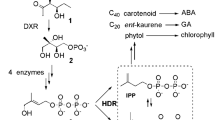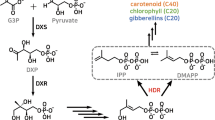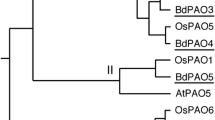Abstract
Isoprenoids are synthesized through the condensation of five-carbon intermediates, isopentenyl diphosphate (IPP) and dimethylallyl diphosphate (DMAPP), derived from two distinct biosynthetic routes: cytosolic mevalonate (MVA) and plastidial 2-C-methyl-d-erythritol 4-phosphate (MEP) pathways. 1-Hydroxy-2-methyl-2-(E)-butenyl 4-diphosphate reductase (IDS; EC 1.17.1.2), which catalyzes the last step of MEP pathway, was cloned as a multicopy gene from gymnosperms Ginkgo biloba (GbIDS1, GbIDS2, and GbIDS2-1) and Pinus taeda (PtIDS1 and PtIDS2), and characterized. Phylogenetic tree constructed with other plant IDSs demonstrated gymnosperm IDSs were distinctively different from angiosperm IDSs. The gymnosperm IDS clade contained two subclades, one composed of GbIDS1 and PtIDS1, and the other composed of GbIDS2, GbIDS2-1, and PtIDS2. G. biloba IDSs, except GbIDS2-1, successfully complemented Escherichia coli DLYT1, a lytB disruptant, confirming the in vivo competency of isozymes. During the 4 weeks study period, although transcript levels of GbIDS1s were similar both in roots and leaves of cultured G. biloba embryo, the transcripts of GbIDS2 predominantly occurred in the embryo roots, where diterpene ginkgolides are biosynthesized. Levels of PtIDS2 transcripts in the diterpenoid resin-producing wood were 4–5 times higher than those in other tissues. Higher levels of GbIDS1 transcripts were induced by light, whereas those of GbIDS2 were increased by methyl jasmonate treatment. These results strongly imply GbIDS2 and PtIDS2 have high correlation with secondary metabolism. In Arabidopsis transient expression system, N-terminal 100 amino acid residues of GbIDS1 delivered fused GFP protein into chloroplast as well as cytosol and nucleus, whereas those of GbIDS2, GbIDS2-1, and two PtIDSs delivered GFP only into chloroplast.







Similar content being viewed by others
Abbreviations
- DMAPP:
-
Dimethylallyl diphosphate
- DXR:
-
1-Deoxy-d-xylulose 5-phosphate reductoisomerase
- DXS:
-
1-Deoxy-d-xylulose 5-phosphate synthase
- GAP:
-
d-glyceraldehyde 3-phosphate
- HMBPP:
-
1-Hydroxy-2-methyl-2-(E)-butenyl 4-diphosphate
- IDI:
-
Isopentenyl diphosphate isomerase
- IPP:
-
Isopentenyl diphosphate
- MEP:
-
2-C-methyl-d-erythritol 4-phosphate
References
Abel S, Theologis A (1994) Transient transformation of Arabidopsis leaf protoplasts: a versatile experimental system to study gene expression. Plant J 5:421–427
Altincicek B, Kollas A, Eberl M, Wiesner J, Sanderbrand S, Hintz M, Beck E, Jomaa H (2001) LytB, a novel gene of the 2-C-methyl-d-erythritol 4-phosphate pathway of isoprenoid biosynthesis in Escherichia coli. FEBS Lett 499:37–40
Balakirev ES, Ayala FJ (2003) Pseudogenes: are they “junk” or functional DNA? Annu Rev Genet 37:123–151
Bick JA, Lange BM (2003) Metabolic cross talk between cytosolic and plastidial pathways of isoprenoid biosynthesis: unidirectional transport of intermediates across the chloroplast envelope membrane. Arch Biochem Biophys 415:146–154
Botella-Pavía P, Besumbes O, Phillips MA, Carretero-Paulet L, Boronat A, Rodríguez-Concepción M (2004) Regulation of carotenoid biosynthesis in plants: evidence for a key role of hydroxymethylbutenyl diphosphate reductase in controlling the supply of plastidial isoprenoid precursors. Plant J 40:188–199
Braquet P, Spinnewyn B, Braquet M, Bourgain RH, Taylor JE, Etienne A, Drieu K (1985) BN 52021 and related compounds: a new series of highly specific PAF-acether antagonists isolated from Ginkgo biloba. Blood Vessels 16:559–572
Carretero-Paulet L, Ahumada I, Cunillera N, Rodríguez-Concepción M, Ferrer A, Boronat A, Campos N (2002) Expression and molecular analysis of the Arabidopsis DXR gene encoding 1-deoxy-d-xylulose 5-phosphate reductoisomerase, the first committed enzyme of the 2-C-methyl-d-erythritol 4-phosphate pathway. Plant Physiol 129:1581–1591
Cartayrade A, Neau E, Sohier C, Balz JP, Carde JP, Walter J (1997) Ginkgolide and bilobalide biosynthesis in Ginkgo biloba. I: sites of synthesis, translocation and accumulation of ginkgolides and bilobalide. Plant Physiol Biochem 35:859–868
Chang S, Puryear J, Cairney J (1993) A simple and efficient method for isolation RNA from pine trees. Plant Mol Biol Rep 11:113–116
Eisenreich W, Bacher A, Arigoni D, Rohdich F (2004) Biosynthesis of isoprenoids via the non-mevalonate pathway. Cell Mol Life Sci 61:1401–1426
Flugge UI, Gao W (2005) Transport of isoprenoid intermediates across chloroplast envelope membranes. Plant Biol 7:91–97
Gräwert T, Kaiser J, Zepeck F, Laupitz R, Hecht S, Amslinger S, Schramek N, Schleicher E, Weber S, Haslbeck M, Buchner J, Rieder C, Arigoni D, Bacher A, Eisenreich W, Rohdich F (2004) IspH protein of Escherichia coli: studies on iron-sulfur cluster implementation and catalysis. J Am Chem Soc 126:12847–12855
Grieshaber NA, Sager JB, Dooley CA, Hayes SF, Hackstadt T (2006) Regulation of the Chlamydia trachomatis histone H1-like protein Hc2 is IspE dependent and IhtA independent. J Bacteriol 188:5289–5292
Hanson MR, Köhler RH (2001) GFP imaging: methodology and application to investigate cellular compartmentation in plants. J Exp Bot 52:529–539
Hecht S, Eisenreich W, Adam P, Amslinger S, Kis K, Bacher A, Arigoni D, Rohdich F (2001) Studies on the nonmevalonate pathway to terpenes: the role of the GcpE (IspG) protein. Proc Natl Acad Sci USA 98:14837–14842
Keeling CI, Bohlmann J (2006a) Diterpene resin acids in conifers. Phytochemistry 67:2415–2423
Keeling CI, Bohlmann J (2006b) Genes, enzymes and chemicals of terpenoid diversity in the constitutive and induced defence of conifers against insects and pathogens. New Phytol 170:657–675
Kim SM, Kuzuyama T, Chang YJ, Kim SU (2006a) Cloning and characterization of 2-C-methyl-d-erythritol 2,4-cyclodiphosphate synthase (MECS) gene from Ginkgo biloba. Plant Cell Rep 25:829–835
Kim SM, Kuzuyama T, Chang YJ, Kwon HJ, Kim SU (2006b) Cloning and functional characterization of 2-C-methyl-d-erythritol 4-phosphate cytidyltransferase (GbMECT) gene from Ginkgo biloba. Phytochemistry 67:1435–1441
Kim SM, Kuzuyama T, Chang YJ, Song KS, Kim SU (2006c) Identification of class 2 1-deoxy-d-xylulose 5-phosphate synthase and 1-deoxy-d-xylulose 5-phosphate reductoisomerase genes from Ginkgo biloba and their transcription in embryo culture with respect to ginkgolide biosynthesis. Planta Med 72:234–240
Kuzuyama T, Seto H (2003) Diversity of the biosynthesis of the isoprene units. Nat Prod Rep 20:171–183
Lois LM, Campos N, Putra SR, Danielsen K, Rohmer M, Boronat A (1998) Cloning and characterization of a gene from Escherichia coli encoding a transketolase-like enzyme that catalyzes the synthesis of D-1-deoxyxylulose 5-phosphate, a common precursor for isoprenoid, thiamin, and pyridoxol biosynthesis. Proc Natl Acad Sci USA 95:2105–2110
Lois LM, Rodríguez-Concepción M, Gallego F, Campos N, Boronat A (2000) Carotenoid biosynthesis during tomato fruit development: regulatory role of 1-deoxy-d-xylulose 5-phosphate synthase. Plant J 22:503–513
Martin D, Tholl D, Gershenzon J, Bohlmann J (2002) Methyl jasmonate induces traumatic resin ducts, terpenoid resin biosynthesis, and terpenoid accumulation in developing xylem of Norway spruce stems. Plant Physiol 129:1003–1018
McGarvey DJ, Croteau R (1995) Terpenoid metabolism. Plant Cell 7:1015–1026
Peñuelas J, Munné-Bosch S (2005) Isoprenoids: an evolutionary pool for photoprotection. Trends Plant Sci 10:166–169
Querol J, Campos N, Imperial S, Boronat A, Rodríguez-Concepción M (2002) Functional analysis of the Arabidopsis thaliana GCPE protein involved in plastid isoprenoid biosynthesis. FEBS Lett 514:343–346
Rodríguez-Concepción M, Boronat A (2002) Elucidation of the methylerythritol phosphate pathway for isoprenoid biosynthesis in bacteria and plastids. A metabolic milestone achieved through genomics. Plant Physiol 130:1079–1089
Rohmer M, Knani M, Simonin P, Sutter B, Sahm H (1993) Isoprenoid biosynthesis in bacteria: a novel pathway for the early steps leading to isopentenyl diphosphate. Biochem J 295:517–524
Rolland F, Gonzalez EB, Sheen J (2006) Sugar sensing and signaling in plants: conserved and novel mechanisms. Ann Rev Plant Biol 57:676–709
Stahl FW, Kobayashi I, Thaler D, Stahl MM (1986) Direction of travel of RecBC recombinase through bacteriophage lambda DNA. Genetics 113:215–227
Takagi M, Kuzuyama T, Takahashi S, Seto H (2000) A gene cluster for the mevalonate pathway from Streptomyces sp. strain CL190. J Bacteriol 182:4153–4157
Trapp SC, Croteau RB (2001) Genomic organization of plant terpene synthases and molecular evolutionary implications. Genetics 158: 811–832
Walter MH, Floss DS, Hans J, Fester T, Strack D (2007) Apocarotenoid biosynthesis in arbuscular mycorrhizal roots: contributions from methylerythritol phosphate pathway isogenes and tools for its manipulation. Phytochemistry 68:130–138
Walter MH, Hans J, Strack D (2002) Two distantly related genes encoding 1-deoxy-d-xylulose 5-phosphate synthases: differential regulation in shoots and apocarotenoid-accumulating mycorrhizal roots. Plant J 31:243–254
Zhou D, White RH (1991) Early steps of isoprenoid biosynthesis in Escherichia coli. Biochem J 273:627–634
Acknowledgments
The authors appreciate support from the Korea Science and Engineering Foundation (KOSEF 981-0608-040-2) through PMRC, and the Brain Korea 21 program administered by the Ministry of Education and Human Resources Development, Korea, through the Graduate School of Agricultural Biotechnology, SNU.
Author information
Authors and Affiliations
Corresponding author
Additional information
GenBank accession numbers: GbIDS1 (DQ251631) · GbIDS2 (DQ251633) · GbIDS2-1 (DQ251632) · PtIDS1 (EF095154) · PtIDS2 (EF095155).
Rights and permissions
About this article
Cite this article
Kim, SM., Kuzuyama, T., Kobayashi, A. et al. 1-Hydroxy-2-methyl-2-(E)-butenyl 4-diphosphate reductase (IDS) is encoded by multicopy genes in gymnosperms Ginkgo biloba and Pinus taeda . Planta 227, 287–298 (2008). https://doi.org/10.1007/s00425-007-0616-x
Received:
Accepted:
Published:
Issue Date:
DOI: https://doi.org/10.1007/s00425-007-0616-x




